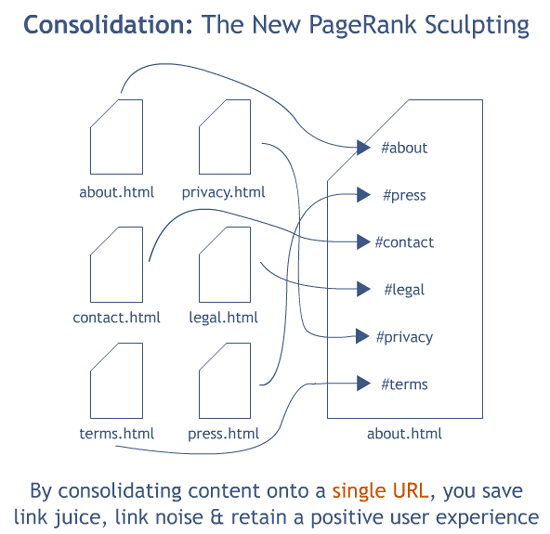
Link Consolidation: The New PageRank Sculpting
We've all been bored to tears (or driven to madness) by the PageRank Sculping debate that's arisen since Google's June announcement. But, behind the scenes, a lot of smart SEOs have been working on ways to provide the same benefits that were thought to be conferred by PR sculpting with nofollow through alternate methods. Out of the few that have emerged, the one I believe has the most promise and best opportunity is "Link Consolidation."
Let's, briefly, frame the issue and then I'll dive into how this solution works.
#1 - Google is now "evaporating" link juice through nofollow'd links (see image below)

#2 - Selecting which links receive juice on a page is still critically important (note this discussion between Danny Sullivan and Google's Matt Cutts):
Danny: PageRank isn’t spread equally among links and hasn’t been for years and years, right? As I said at the beginning, this is what I long understood to be the case from things Google hinted at before 2007. And at SMX Advanced, you confirmed it to be the case. So really, isn’t the better explanation simply this?
“Google itself solely decides how much PageRank will flow to each and every link on a particular page. The number of links doesn’t matter. Google might decide some links don’t deserve credit and give them no PageRank. The use of nofollow doesn’t “conserve” PageRank for other links; it simply prevents those links from getting any PageRank that Google otherwise might have given them.”
Matt: I did this post because I wanted people to understand more about PageRank, how it works, and to clarify my answers at SMX Advanced. Yes, I would agree that Google itself solely decides how much PageRank will flow to each and every link on a particular page. But that’s no reason to make PageRank a complete black box; if I can help provide people with a more accurate mental model, overall I think that’s a good thing. For example, from your proposed paragraph I would strike the “The number of links doesn’t matter” sentence because most of the time the number of links do matter, and I’d prefer that people know that.
#3 - Doing good things for SEO shouldn't get in the way of a good user experience (thus we can't just go willy-nilly excluding links to pages that engines might not care about but visitors do)
At SEOmoz, we had a long talk about we're going to handle the nofollow/sculpting issue, both with regards to our own site (where we'd like to maximize the juice flowing to good, useful places) and to those of our clients and PRO members who ask for help via Q+A. A few issues arose:
- Hiding/redirecting links with javascript is both a dev pain, and it excludes approx. 4% of our visitors who don't have javascript enabled (as well as hurting mobile users with less robust browser experiences)
- Hiding links inside Flash files likewise excludes about 7% of our users
- Cloaking links could get us into trouble with search engine guidelines
One solution that emerged here (and, from my talks with other SEOs in the community, found widespread appeal) is "Link Consolidation." Put simply, consolidation is the practice of minimizing the number of pages that are linked to by consolidating content onto fewer pages. This graphic explains far better than words can:

As with any technique, there are lots of caveats around user experience, when to apply, etc. However, the basic tenant - moving from linking to 6 URLs on every page to 1 achieves many of the goals that classic nofollow link sculpting attempted. There are lots of areas where we've traditionally used nofollows that this makes sense:
- Login/Register Pages - why not make a single page for both those seeking to register and login?
- Terms of Service / Privacy / Legal Disclaimer - a single page with internal anchors works very well and puts all the attorney goodness in one spot.
- About/Bios/Contact/Press - even if you have detail pages you want to link to with specifics, a single page where users can see the overview and make a simple choice of where to go is sensible.
- Comment/User Links in UGC - many systems already apply this methodology, but again, it's possible to consolidate user information onto a single URL rather than having multiple pages about a single user (there's lots of other UGC applications for this as well).
- Pagination - although technically it's not the same as the other examples, many sites use AJAX to reload pages with hash tag data, and this can work here too.
The user experience, in most cases, won't degrade because visitors can still link to, bookmark and share the URLs. The engines see fewer links per page, so they can pass more juice to the places that matter most. And, finally, your developers don't have to code up a lot of fancy material just to prevent PageRank leaks.
Granted, this solution is not universal, and in fact is not quite as clean as the nofollow sculpting process (given the choice, I wish we could back to using nofollow). However, by getting creative and applying this process intelligently (don't forget about the user!), you can achieve many of the same benefits with very little drawback.
Looking forward to hearing your thoughts!
The author's views are entirely their own (excluding the unlikely event of hypnosis) and may not always reflect the views of Moz.



Comments
Please keep your comments TAGFEE by following the community etiquette
Comments are closed. Got a burning question? Head to our Q&A section to start a new conversation.